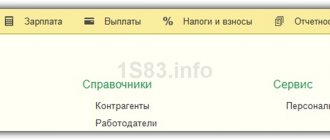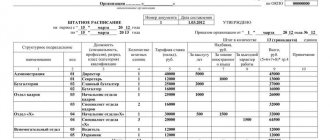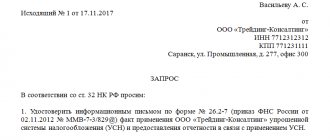Why do you need staffing at all?
The staffing table is a document necessary for the formation of the staffing structure and number of the organization in full accordance with the Charter of the enterprise. This document contains a list of structural divisions of the organization, a list of positions, names of specialties and professions indicating qualifications, as well as data on the required number of certain staff units. To compile it, the unified form T-3 is used, which is approved by the Resolution of the State Statistics Committee of Russia.
From the employer’s point of view, the staffing table performs a number of important functions and allows for maximum optimization and streamlining of the institution’s work. Using a staffing table allows you to clearly see the entire structure of the organization with its divisions, record the number of staff units, control the number and quality of employees, monitor the wage system and the amount of allowances. And when vacancies arise, it greatly simplifies the selection of personnel.
Is the staffing table a mandatory document?
Interestingly, there is no clear answer to this question. On the one hand, the Labor Code addresses the issue of staffing, since this document concerns the labor function of an employee of an organization and the remuneration of personnel. And the employment contract states that the employee performs duties in accordance with the staffing schedule. There is a unified form of the staffing table, and this document is also mentioned in the Instructions for maintaining work books (entries in the work book are made taking into account the name of the position in accordance with the staffing table). This means that the organization must have a staffing table. But, on the other hand, not a single regulatory act directly states the employer’s obligation to introduce a staffing table. And yet, it is better to draw up this personnel document, since most inspection bodies consider it mandatory for any organization.
For example, tax authorities and the Social Security Fund always request staffing when conducting on-site audits. Using it, they verify the correctness of the calculation of insurance premiums, collect information about the insurance experience of employees, and monitor the correctness of taxation. The fact that the staffing table is not a tax accounting document does not relieve the employer of the need to provide it during inspections at the request of third-party organizations. And its absence can be regarded as a violation of labor legislation, for which a fine for the organization is imposed in the amount of 50,000 rubles. Of course, it can be challenged in court (especially since there is no direct indication in the law of the employer’s obligation to draw up a staffing table), but first you will have to pay it.
https://youtu.be/V9HVmdzuGO4
Mandatory or not?
In any employment contract, including a fixed-term one, when hiring an employee, it is indicated that he was hired in accordance with the staffing table.
Moreover, during on-site inspections, social insurance and tax officials always request a document. The absence of one is often regarded as a violation of the Labor Code of the Russian Federation, for which the company can be fined.
In any case, to avoid problems, it is better to draw up a staffing table.
Frequency of drawing up staffing schedules
How often do you need to create a new staffing table? There is also no clear answer to this question. But in this situation, you should be guided by logic: since the staffing table is a planning document, then it is advisable to draw it up for one calendar year or six months. This will allow, if necessary, to regulate the number of personnel of the organization and its qualitative composition. But, at the same time, it is possible to approve the staffing table for several years (if the organization does not need to introduce new positions).
Job categories
For 2020, the legislator has not developed rules regarding the uniform formation of job titles in the schedule. The norms prescribed in the standards are subject to compliance in certain working conditions and in structures of state importance. Many companies follow their own rules when naming positions.
https://youtu.be/dfo56oFg5_E
An example of a trendy job title in an organization would be manager. In fact, this is the same cleaning lady. However, the position is called cleaning service manager. This name is used to encourage people to work.
When the number of staff in an organization is small, one person can occupy two positions at once.
Who develops and approves the staffing schedule?
If the company does not have a staffing table, but management decided to develop one, a reasonable question arises: who should do it? The legislation again does not give an unambiguous answer to this. Therefore, the manager can do this himself, determining the circle of responsible persons who will help him. It would be logical if these were HR employees, chief accountant, employees of the legal or economic planning department. And if the enterprise has a department for organizing labor and wages, you can entrust this work to them. Responsibilities for developing and drawing up the staffing table for 2014 may be reflected in the employee’s employment contract or his functional responsibilities.
Approval of the staffing table relates to the powers of the head of the organization or the person to whom these powers are transferred by order of the head. To approve the staffing table, the manager must sign a special order or instruction. The details of this document must be indicated in the field of the unified form T-3 “Approved by order of the organization dated “__”_______20__No__”. In this case, the approval date and the effective date of the staffing table may not coincide (the effective date is usually later).
Who does this?
The legislator does not indicate who is responsible for drawing up the staff document. In practice, it is established that these can be:
- persons holding leadership positions;
- a group of persons specially created for this purpose;
- HR employee;
- economic department;
- legal department;
- department for labor organization and wages.
It is required that a specialist from the economic department participate in the preparation of the act.
How long does it last?
The periods for storing documentation are established by the Federal Archive. According to the acts developed by this department, the storage period will be three years. The countdown of the period begins from the moment the document ceases to be valid.
When does it change?
According to the directory, which indicates the qualifications of the positions of employees, subordinates and superiors, responsibility for registration rests with the labor economist. Considering the fact that not all companies have the specified position, management makes a decision regarding the performance of the work in question.
Sample order for amendments
As a rule, when drawing up an act, production tasks and the amount of work are used. According to the specified data, staff is recruited and the funds required to pay advance payments established at the legislative level are calculated.
The structure of an enterprise is not eternal, since adjustments are made to it, it changes and develops. Changes may be associated with an increase in the number of zones, service by the organization, adjustment of the types of activities in which the enterprise is engaged.
Due to the presence of such circumstances, the form of work activity changes, which may entail a change in the number of members of the company towards an increase or decrease.
https://youtu.be/avpa0GPoQdU
The introduction of adjustments is also associated with changes in tariff rates. Regarding the minimum wage, changes in legislation are regularly adopted to increase it. In this case, the employer, based on its financial capabilities, has the right to increase the salary.
Adjustments are made to the act on the basis of documentation developed in the accounting department.
For wartime
Institutions and organizations of various forms have the right to adopt a schedule for a period of time considered military. Drawing up and filling out the act does not cause difficulties, since it is carried out in the same way as the standard procedure.
The basis for the process under consideration is the mobilization task received from the military registration and enlistment office and other structures, for example, the Ministry of Emergency Situations. According to the received documentation, the number of staff is calculated, after which the information is entered into the act.
The hospital inpatient unit received a task for the war period regarding the installation of additional beds in the amount of 250 units.
After reviewing the requirement, managers decide how many workers they will need to serve patients. Next, a schedule is drawn up and approved by issuing an order.
Structural subdivision
The first column of the document in question is called “Name of the structural unit.” When the schedule is drawn up for commercial organizations, there are no restrictions regarding the names of departments.
Only terminological requirements are taken into account; they indicate that it is not advisable to name a unit with a little-known foreign word.
https://youtu.be/ki3bUyCSCIQ
In some organizations, the name of the department affects the employee's receipt of benefits. Examples include healthcare and education institutions. In this case, the personnel department employees take on the task of correctly indicating the name of the department.
In order to facilitate the work of the HR department, classifiers regarding hazardous industries and other lists have been created. Names are entered in relation to group affiliation:
- the manual is initially indicated;
- production;
- auxiliary.
How long is the staffing table kept?
Rosarkhiv establishes certain storage periods for standard management documents, according to which the institution’s staffing table must be stored for three years, starting from the year following the one in which the document became invalid. As for staffing arrangements, which will be discussed in the next section, they are stored for seventy-five years after new ones are compiled.
Staffing is a help in the work of the HR department
In some organizations, the HR department maintains a staffing table - a mobile version of the staffing table, which reflects all vacant positions, as well as all information on filling positions (full names of current employees, position status, etc.). The staffing arrangement provides the necessary information about changes in personnel, contains personnel numbers of employees, information about the length of service and categories (minors, disabled people, pensioners, having children under three years old, etc.) of employees.
When drawing up the staffing structure, the current staffing table is taken as a basis, to which the necessary columns are added. This document is not mandatory and the organization does not have to maintain it. But the staffing arrangement is a fairly convenient document, especially for large organizations, which allows you to optimize the work of personnel officers and clearly control the filling of vacant positions. Therefore, it is often used as an internal document.
Difference from the standard arrangement
In many enterprises, along with the main schedule, the so-called working form is used - staffing.
This is a simplified form containing a list of professions and positions to be filled.
Unlike the T-3 form, it is operational in nature, it changes dynamically depending on numerical or qualitative transformations and does not require a separate order to change or approve it.
Typically, the job description indicates information about specific employees occupying a particular position or vacancy status (occupied or free), in contrast to the main one, which shows only the number of vacancies.
SR does not make it possible to understand which employee fills which position and whether a certain vacancy is filled or not.
The document is not mandatory, but it is quite convenient for operational personnel work, especially in large companies; it is often used for operational control of filling vacancies.
Staffing table: rules for drawing up
Let's consider drawing up a staffing table based on the unified T-3 form. To receive a completed document, you just need to fill out the form, following the Instructions for filling out forms of primary accounting documentation.
"A cap". When filling out the “header”, you need to indicate the name of the organization in the “Name” field (this is done in accordance with the registration certificate), OKPO code, document number and date of preparation. In the field “Staffing table for the period...” you need to indicate only the date of entry into force of this document.
Content part. The staffing form involves numbering the columns of the content of the document, which adds convenience when working with it. There are ten counts in total. Let's fill them in one by one.
- Column 1 “Name”. We indicate the name of the structural unit, workshop, representative office, branch, arranging the structural units according to the existing hierarchy.
- Column 2 “Code”. We indicate the code of the structural unit assigned to it by the head of the organization.
- Column 3. We indicate the position (specialty, profession), rank, class (category) of the employee’s qualifications in accordance with the All-Russian Classifier of Professions and the Qualification Directory of Managers and Specialists. Here it should be taken into account that the position for which the employee is hired must sound the same both in the staffing table and in the employment contract, as well as in the work book.
- Column 4 “Number of staff units.” We indicate the number of staff positions for the relevant positions. If there are incomplete units, they should be indicated in fractions, for example, 2.75. And if there are vacant positions, they are also indicated.
- Column 5 “Tariff rate”. We indicate the salary, tariff schedule, percentage of revenue, share of profit - it all depends on what kind of remuneration system operates in a particular organization. The main thing is to indicate the amount in ruble equivalent and remember that the salary (tariff rate) cannot be lower than the minimum wage.
- Columns 6, 7, 8 “Allowances”. We indicate the provided incentive and compensation payments. These can be bonuses, additional payments, incentive payments, allowances, which can be established both by the legislation of the Russian Federation and by the employer. Such payments may be fixed amounts or percentage increases.
- Column 9. Indicate the total amount in columns 5-8. That is, we sum up the salaries and all the required allowances and display the total value in rubles. If the data is given as a percentage, we display the percentage.
- Column 10 is for notes. If there are none, it is left blank.
After all the fields are filled in, you need to fill in the “Total” line. It summarizes all the indicators in vertical columns: it indicates how many staffing units are provided for in the schedule, the amount of salaries (tariff rates), allowances and the amount of the monthly wage fund.
The staffing table is signed by the head of the human resources department or an authorized person, as well as the chief accountant of the organization. You can put a stamp on the document, but it is not necessary.
Here you can download the staffing form
Nuances
Is rounding of staff positions allowed?
All staff positions are filled in accordance with the rate; if the schedule indicates that the position is determined at half the rate, then rounding to a whole number is not allowed.
How to restore if it was lost or damaged?
To restore, you will need to take several steps, namely:
- Study all documents available at the enterprise.
- Check the availability of personnel documents and their completeness.
- Analyze the content of all employment contracts available to the HR department.
- Check and analyze all work books located in the personnel.
- Based on the analysis, create a worksheet where you can enter all the employees of the enterprise, their positions, and other available data.
- Systematize the worksheet and, based on it, draw up a new staffing table, approve it according to the rules.
How often can I change?
The legislation does not specify how often and for what period, but given that the document is essentially planned, it is assumed that it should be updated annually, along with other accounting documentation.
However, if no major changes occur in the organization’s personnel policy, then a document issued once may be valid for more than one year; it will be enough to issue a list of changes.
How to reflect hourly wages?
In column 5 of the staffing table, the standard wage per hour is indicated, then in column 10 a note is made: “Hourly wages” and a link is given to the provision that regulates this remuneration procedure.
How to reflect part-time in a document?
Half the bet is written as 0.5 bets, a quarter is 0.25 bets.
Is it required for a separate division of the organization?
There is no need to create a separate schedule for a separate unit, since it contains information about all structural units.
But it is not prohibited by law to have more than one standard in a company, therefore, if the charter of an enterprise stipulates that a representative office or branch can have a separate standard, then it can be approved by the head of a separate division.
Is it necessary to register if there are no employees, just one director?
If the organization consists of one employee, then registration is not required.
How to reflect surcharges?
If the bonus is calculated not on the salary, but on the entire amount of the accrued salary, then its size is not indicated, and in column 10 a reference is written to the standard according to which this bonus is calculated.
https://youtu.be/k04Jf3rVQdY
Attention!
- Due to frequent changes in legislation, information sometimes becomes outdated faster than we can update it on the website.
- All cases are very individual and depend on many factors. Basic information does not guarantee a solution to your specific problems.
That's why FREE expert consultants work for you around the clock!
- via the form (below), or via online chat
- Call the hotline:
- Moscow and the Region
- St. Petersburg and region
- Regions - 8 (800) 222-69-48
APPLICATIONS AND CALLS ARE ACCEPTED 24/7 and 7 days a week.
Personnel
Change of staffing
Even established staffing schedules have to be changed from time to time. The reason for such changes may be the need to introduce a new unit or division into the staff or, conversely, to reduce the existing staff. In addition, there may be a need to change salaries, tariff rates, as well as the need to rename positions or departments.
There are two options for making changes to the staffing table:
- develop and approve a new staffing table;
- make changes to the current staffing table.
In the first case, the staffing table is developed on the basis of the current one, but taking into account the necessary changes, and is put into effect from the beginning or middle of the calendar year. If there is an urgent need, then from the beginning of the new month.
As for making changes to the current document without canceling it, they are made in accordance with the order of the head “On changing the staffing table”. The order itself must indicate the basis for making changes to the staffing table (this could be reorganization, staff reduction, improving the structure of the organization, etc.), and also indicate exactly what changes should be made.
In a large organization with a branched structure, it is better to indicate not only the positions that are affected by the change, but also the structural units where these positions are located. In this case, all changes in the staffing table must be brought to the attention of the enterprise’s employees, and also entered into the work books with reference to the basis (order or instruction).
A sample staffing schedule can be downloaded here.
Explanatory note
This act is required when a new schedule is approved, which indicates previously unused positions. The note provides the rationale for the adoption of these changes. The same rule applies to cases where the number of employees is reduced.
Example of an explanatory note
The note is drawn up by the management of the unit where the innovations took place. The adjustments made must be justified. The document is stamped with a visa from the head of the organization, which gives reason to believe that he agrees to such adjustments.
https://youtu.be/FqKNvbtuKxw
Staff reduction: when to make changes?
A reduction in staff or number of employees is one of the grounds for making changes to the staffing table, since a reduction in the size of an organization involves the exclusion of individual staff units from the schedule, and a reduction in staff - positions. In this case, laid-off employees are subject to dismissal (unless they are expected to be transferred to another job).
Since when dismissal due to a reduction in the number or staff of employees, it is necessary to notify about the changes no later than two months in advance, the new staffing table can be put into effect only after this period. Although it can be drawn up in advance, the very presence of a new or changed staffing table, which has already been approved, will confirm the eligibility of dismissing employees. If the circumstances that led to the decision to make a reduction are eliminated, the employer has the right to change the staffing table again in the direction of increasing the number of employees.
Change of the unified form T-3
Resolution of the State Statistics Committee No. 20 of March 24, 1999 allows organizations to make changes to the unified forms of primary accounting documentation (this permission does not apply to the accounting of cash transactions). Therefore, if there is an urgent need, the organization can make its own changes to the finished form, but deleting existing details is not allowed. Changes may concern the expansion or narrowing of columns, the addition of lines or loose leaves. Necessary corrections can be made when producing forms based on a unified form.
https://youtu.be/eVJp5kIGYqA










